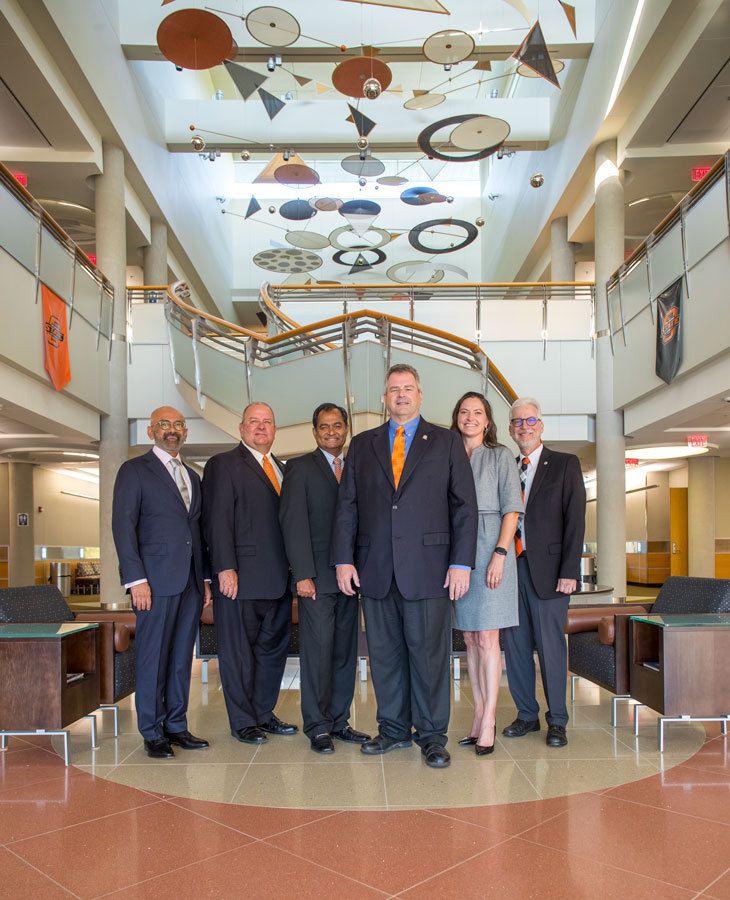
CEAT has undergone a 21st century change in the past 10 years
Monday, December 5, 2022
Media Contact: Kristi Wheeler | Manager, CEAT Marketing and Communications | 405-744-5831 | kristi.wheeler@okstate.edu
The rise of AI, data centers, cyber security, mRNA vaccines, EV, social media, unmanned aircraft, sustainable energy, climate change and COVID-19 have changed our lives in the past decade. These challenges have accelerated the need for engineering, technology and innovative architecture. The faculty and graduates of Oklahoma State University’s College of Engineering, Architecture and Technology are at the very heart of these challenges.
In 2012, CEAT welcomed a new dean, Dr. Paul Tikalsky. He brought with him a persevering attitude and work ethic, along with grand ideas of what CEAT could and should become during his tenure.
“Where we were then, to where we are now, could we have predicted it? I don’t think so,” Tikalsky said. “Without the contributions and leadership from the university, our donors and our college leadership, none of this would’ve been possible.”
The “this” he refers to has been a decade of highs and lows, challenges and triumphs. If you asked anyone associated with CEAT what the last 10 years has been like, the answers would surely consist of highlights of changes in leadership, faculty, students and infrastructure, as well as a transformational forecast for the future of CEAT and those lucky enough to be affiliated with it.
Leaders For The Future
When CEAT students returned for the 2022 fall semester, they found the leadership of the college looked different than it did in the spring, let alone 10 years ago.
For the first time in CEAT history, the departmental leadership is nearly 50% female and along with the executive leadership, consists of the most diverse group of leaders the college has ever had.
The executive committee now looks slightly different. Randy Seitsinger has retired after over 20 years of leadership in CEAT. Dr. Sunderesh Heragu took a step up from his role as the head of the School of Industrial Engineering and Management and is the new associate dean of Academic Affairs.
Also, Carisa Ramming is settling into her new role on the executive committee as the assistant dean of Engagement and Inclusion — a role she assumed in the middle of 2021 after serving as a faculty member in the School of Architecture since 2009. Her role as chief inclusion officer will allow the executive committee to have one of its own members constantly investigating, developing and implementing programs to help all CEAT students feel welcome and have a successful academic and personal experience while at CEAT.
CEAT also welcomed new department heads for several of its schools this fall. Dr. Heather Fahlenkamp assumed the role as head of the School of Chemical Engineering (CHE), as Dr. Geir Hareland, the former head of CHE, now leads energy research at the new Hamm Institute for American Energy at OSU. Fahlenkamp has been a faculty member in CHE since 2006 and has also recently served as the graduate program director for the school.
With Heragu’s move to the CEAT executive team, a new head of the School of Industrial Engineering and Management (IEM) took over this fall. Dr. Camille DeYong returned to OSU and CEAT to head IEM after serving as a faculty member for over 20 years before her retirement.
Lastly, as Dr. Dan Fisher assumes his new role as the director of the soon-to-be-constructed Zink Center for Competitive Innovation, the School of Mechanical and Aerospace Engineering (MAE) has a new leader as Dr. Sandip Harimkar stepped into the role after serving as a faculty member since 2009.
While the leadership of CEAT looks different, the goal will be the same: to provide students a world-class education and rich personal experiences that will allow them to solve the problems of tomorrow.
“Leading isn’t easy,” Tikalsky said. “It takes time to develop those that want to lead. Our leaders face one of the toughest roles in the university setting. The task of balancing what is best for your faculty members, your students and your college can be a daunting one, but one that our team is well-equipped to handle and ready to face with a steadfast commitment to our goals.”
A Diverse And Growing Faculty
The faculty of CEAT has certainly seen members come and go over the last 10 years, which isn’t unexpected or unique, however the benefits of that change cannot be overlooked.
Firstly, the growth in faculty numbers has been substantial, seeing an increase from 166 faculty members in 2016 to 182 faculty members in 2020 and growing. Sixteen additional faculty positions over a four-year period is not an unperceivable change. This number will surely continue to grow with the additional funding provided by the state legislature to address the overwhelming need for more engineers in every field of study. Institutions will undoubtedly see an increased need for high-quality faculty members to handle the desired increase in engineering students in the coming years.
The diversity of those faculty members has also changed during Tikalsky’s tenure. What was once a field dominated by Caucasian males has seen a noticeable and beneficial change in the demographics of its members. In 2012, there were barely over 10 female faculty members in CEAT. As of 2020, there are now more than 30. There has also been a marked increase in the ethnic diversity of CEAT faculty members. The current members are easily the most diverse group of faculty CEAT has ever seen, which provides students a richer and more well-rounded educational experience.
The change in faculty has also brought new approaches to teaching and new ways of engaging students in the engineering challenges that face the world today.
While the faculty of CEAT is saddled with the task of developing the engineers of tomorrow, many of these faculty members are also on the cutting edge of research in their respective fields.
New battery technologies, unmanned system applications and sustainable HVAC technologies are just a few of the numerous fields directly impacted by the research being done by faculty members at CEAT. Researchers completed more than $26.6 million in extramurally funded research over the last year, an unprecedented amount for CEAT.
Future Engineers Solving World’s Problems
A CEAT student in the fall of 2022 undoubtedly looks different than their predecessors in 2012. They are more intelligent on average, due to increased enrollment requirements, more technologically adept and ready to face the challenges of the world.
“We have amazing faculty members. They want to be engaged with the students and be involved with them outside of the classroom, whether through extra help with coursework, mentoring students engaged in extra-curricular projects, providing academic advice, or simply learning more students’ career goals and life aspirations.” Dr. Paul Tikalsky
Despite the aforementioned increase in enrollment requirements, CEAT has increased its annual enrollment numbers by approximately 500 students, on average per year, from 2011 to 2022. Not only is CEAT seeing more students admitted and enrolled, but they are higher quality students due to required test scores and other programs put in place to make sure each student is ready for the rigors of coursework required for an engineering student.
Also, the concerted effort by leadership and faculty to ensure each student is ready for CEAT has increased retention rates, up over 6% to 90.4% from 2016 to 2019. The graduation rate has also seen an increase of nearly 12% from 2016 to 2020. While the demand for engineers continues to increase, Tikalsky and his leadership team are determined to not allow the quality of CEAT student graduates to suffer.
The increase in enrollment can be attributed to many factors, quite possibly the most important being an increase in the amount, both in quantity and dollar amount, of scholarships available to students. Last year, CEAT provided $3.4 million in scholarships to students, including matching scholarship partnerships of $50,000 and $25,000 with the National Action Council for Minorities in Engineering and the Oklahoma Energy Resource Board, respectively.
The constantly increasing demand for engineers has also challenged CEAT to place an even greater emphasis on recruiting than it already has. However, a recently awarded $5 million DOD grant focused on that very thing, increasing STEM education for K-12 students and faculty members across the state, has given CEAT a plethora of additional resources to achieve the goal of widening the STEM pipeline of students.
“We’re trying to find the talent in every town, large and small, in Oklahoma and beyond,” Tikalsky said. “We need to grab that talent, no matter its circumstances, and give it the ability to innovate and change the world.”
This fall, CEAT saw its largest enrollment numbers in female students, as well as several other underrepresented groups. It’s a sign that more and more students are beginning to recognize STEM career fields and the important role they play in today’s society.
The changes don’t stop once students get on campus, either. During Tikalsky’s tenure, there has been an intentional increase in the support programs and resources for undergraduate students in CEAT. The expansion of four-year scholarships in the CEAT Scholar program to 270 students has given CEAT a chance to award more of the best and brightest with paid global educational experience, community service and cultural experiences.
CEAT has also partnered with OSU Housing and Residential Life to develop the Parker Hall Living Learning Program. This has turned a normal dormitory living experience into a true community of CEAT underclassmen with free tutoring, social programming, mental health support programs and access to eight PEATEs — upperclassmen available to provide assistance and advice for any problem, inside or outside the classroom.
CEAT leadership has also made it a priority to increase its diversity, equity and inclusion services and programs. The increase in DEI efforts has created a foundation for everyone in CEAT to feel comfortable and included, which allows for the best possible educational experience for all.
CEAT Summer Bridge is another program that has seen overwhelming success with the students involved. Summer Bridge is a three-week program dedicated to assisting incoming freshmen with acclimating to college life and continuing to build their math and science skills. It also affords these students the opportunity to network with their peers, CEAT faculty and staff and CEAT administrators.
“Summer Bridge has become a transformational program, especially for first generation and underrepresented students, as well as those from smaller high schools,” Tikalsky said.
Finally, a paradigm shift in the approach to coursework and group projects has provided more “real world” experience and opportunities for CEAT students. The idea of transdisciplinary design was implemented by Tikalsky and CEAT administration to break the silos of each discipline and allow students from across the college to work alongside one another toward common goals.
This ideology has given rise to senior design projects that truly challenge students with real-world problems often sponsored and supported by industry partners. The symbiotic relationship between the college and its partners has paid dividends for both parties.
A Growing Footprint
Lastly but probably most noticeably, the college has undergone transformational growth and change in infrastructure over the last 10 years.
CEAT has opened new lab spaces, such as ENDEAVOR, EXCELSIOR and the Bert Cooper Lab, as well as renovated some of its existing infrastructure to match its peers and bring the educational and office spaces into the 21st century.
The ENDEAVOR lab is an innovative, one-of-a-kind undergraduate lab and makerspace that opened in the fall of 2018. The 72,000 square foot building is the centerpiece of an expansion of instruction beyond the classroom as a means to increase undergraduate laboratory and exploratory time for transdisciplinary, hands-on, industryaligned learning.
“ENDEAVOR has proven to not be just a building, but a paradigm shift for CEAT,” Tikalsky said. “It has enabled us to promote a transdisciplinary design model, enhance the undergraduate research program and truly allowed our students to shape their own future.”
EXCELSIOR has given a home to the Unmanned Systems Research Institute, which is dedicated to the expansion and implementation of unmanned technologies as an answer to some of the world’s most difficult and paramount challenges.
The North Campus Lab complex continues to grow and provides CEAT students and faculty access to cuttingedge technology and instruments used by some of the biggest companies and industry partners in the world.
The renovation of Engineering North has provided a state-of-the-art home to several of the schools within CEAT. The learning areas and community and office spaces have provided a place for each school to encourage engagement between students and faculty.
The ongoing renovation of the Engineering South building is the last large piece in the current growth plan of CEAT. Once finished, the building will provide a home to electrical and computer engineering as well as MAE. The building will house the Zink Center for Competitive Innovation and the Chickasaw STEM Auditorium, which will both play a role in the growing shift toward transdisciplinary instruction and design.
The renovation is estimated to be complete in July 2023.
Keep Moving Forward
The next chapter for CEAT looks decidedly different than it did 10 years ago, each chapter building upon the last. The last decade has not been without its share of trials, tribulations and struggles. However, Tikalsky has always used the motto of “keep moving forward” no matter what.
“There will be lots of obstacles and challenges telling you to stop, but as soon as you do, you’ve failed,” Tikalsky said. “Some things work and some things don’t. Recognize the things that work and discard those that don’t, just keep moving forward.”
The personal impact of the last decade is not unnoticed by Tikalsky.
“When you choose to be a department head or a dean, you choose to create the opportunity for success for others,” Tikalsky said. “I miss being in the classroom, conducting research and the personal interactions with students. However, I made a choice years ago that recognized my effectiveness at providing the opportunity for others to be successful, then maybe that’s the best way I can make an impact for the institution. Giving students and faculty the opportunity to teach at an amazing institution is a huge reward for me.”
The changes in leadership; the growth of faculty; the increased quality of students; the expansion and enhancement of infrastructure; the support of donors and industry partners; they have all played invaluable roles in the success and impact of CEAT students, faculty and staff.
“We’ve been very successful over the last 10 years,” Tikalsky said. “I’m lucky to be surrounded by amazing people that look at our mission and say ‘What can we do next?’”
A decade of transformational growth
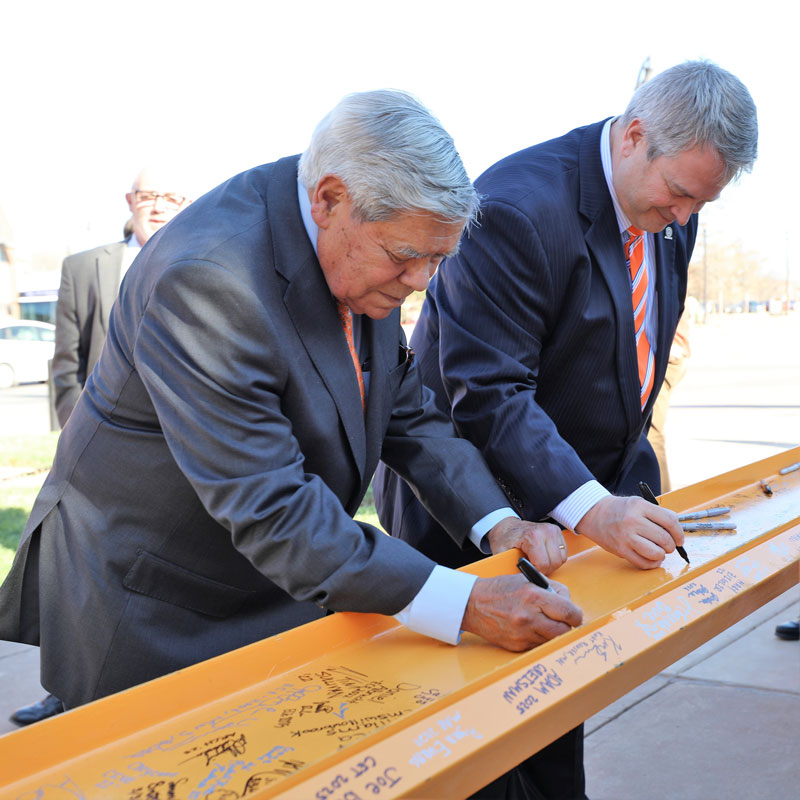



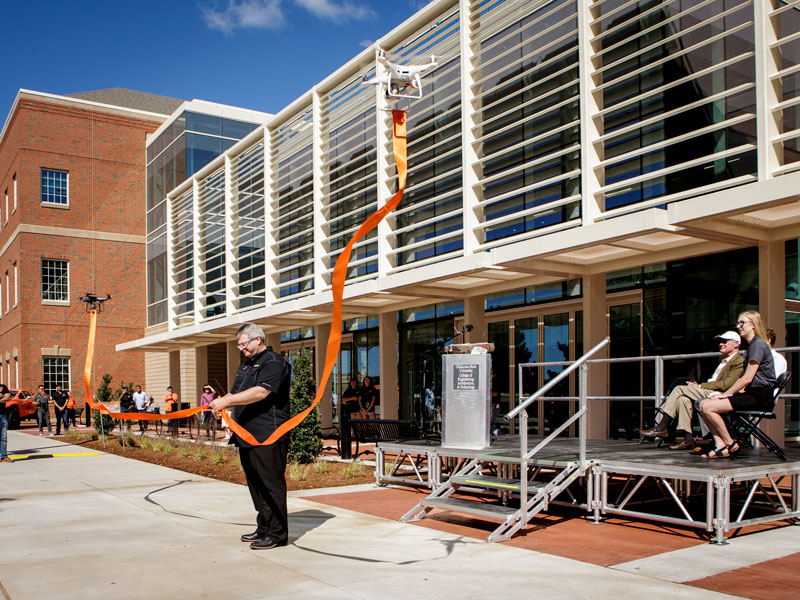

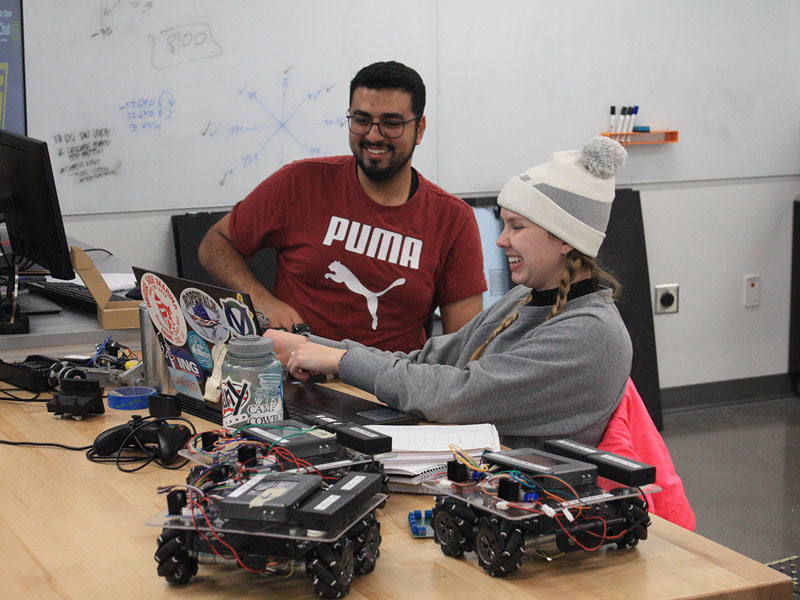

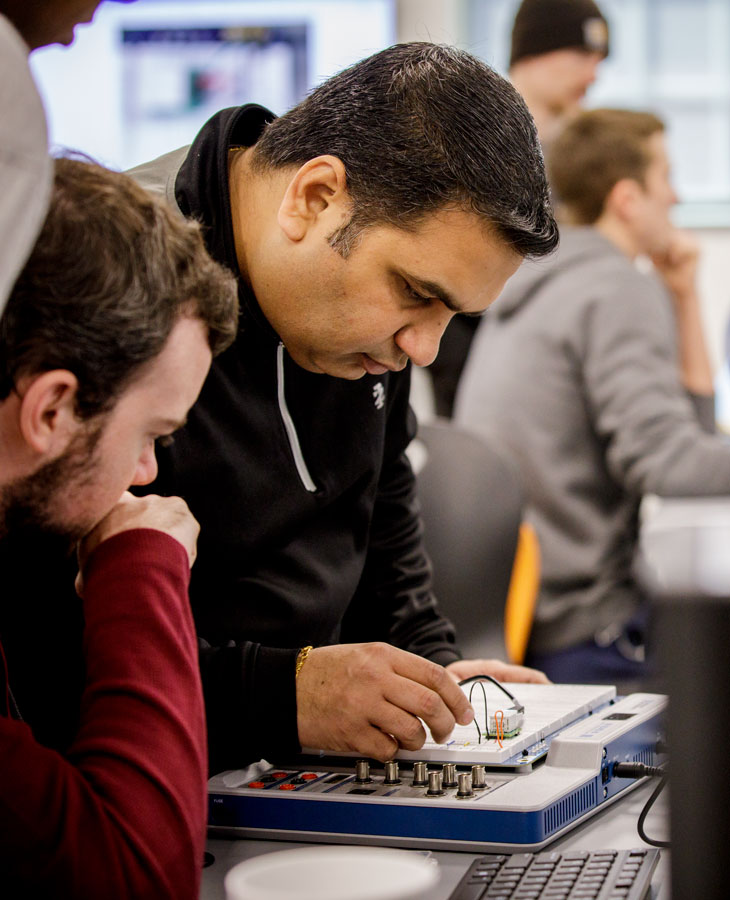







Photos: Kristi Wheeler, CEAT Marketing, Phil Shockley and Gary Lawson
Story by: Jeff Hopper | IMPACT Magazine
